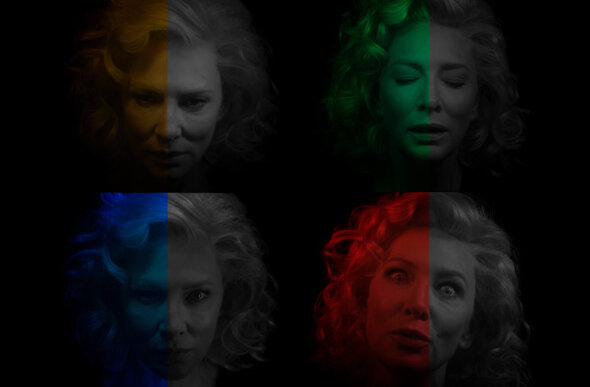MARCO BRAMBILLA | The Four Temperaments (Cate) 11. September 2020 - 28. November 2020
In The Four Temperaments, Cate Blanchett performs four sets of distinct character types divided according to a personality classification first defined by the Greek philosopher, Galen.
He named the four “Temperaments”: Sanguine (Yellow), Choleric (Red), Melancholic (Blue), and Phlegmatic (Green).
In the work, the characters performed by Blanchett each appear in a matrix of four synchronized images. The character fixes her gaze and addresses the viewer with the words “I Love you”. As further characters are introduced, the emotional charge of the statement shifts across the spectrum of the four temperamental types.
As additional characters are introduced, their affections switch, now stating “I don’t love you”. Before long, the opposing sides of each character clearly all performed by Blanchett are confronting the viewer with conflicting emotions articulated in wildly different ways.
The slowly-building chorus of “I Love You” becomes overwhelming before the dissonant chord of “I don’t Love you” gradually begins to displace the affirmations which preceded it.
The repetition of dialogue creates a multi-layered audio track where cascading sets of the two lines are mixed in a similar way to a musical score with overlapping tempos and rhythms within the line deliveries.
The Four Temperaments confronts with familiar emotions shifting between intimacy and distance, gentleness and brutality; the overall effect assigns a crescendo of disquiet on the viewer/voyeur who inadvertently becomes the subject in the a cross-fire of emotions, the repetition of which make them at once engaging and generic.
In The Four Temperaments, four sets of distinct character types are divided according to a personality classification defined by the Greek philosopher, Galen.
The Sanguine (Yellow) speak the language of people and fun. They are carefree, love genuinely and in the most romantic manner. They are often unstable.
The Choleric (Red) speak the language of power and control. They perceive love as a weakness. They can deceive.
The Phlegmatic (Green) speak the language of calm and harmony. They need love to attend to their insecurities. They can be distant.
The Melancholic (Blue) speak the language of perfection and order. They see love as a solace and will only love once. They are known to be unforgiving.
Marco Brambilla | Nude Descending a Staircase
Nude Descending a Staircase No.3 by Marco Brambilla is a kinetic interpretation of Marcel Duchamp’s seminal cubist 1912 masterpiece Nude Descending Staircase, No. 2.
The original 1912 painting, is often identified as a moment where an artist drew from a “new” technology (Eadweard Muybridge’s photographic time-studies) as inspiration for a painting.
Nude Descending a Staircase No.3 transposes the iconic Duchamp painting from a still image to a moving image, one now bound by the dimensions of time and space. The alluded movement in the original painting is explored by Brambilla via a multitude of collaged figures constantly reconfigure and refresh themselves, whilst cascading down immaterial stairs. The figures, shapes and colour palette are inspired by the composition of the original painting, now realised in three dimensions using motion-capture and state-of-the-art machine learning technology.
By taking the original Duchamp painting back into the nascent technological realm and adding the dimension of time, Brambilla completes the circle and pays homage to the deconstructed image using a wholly contemporary visual language.



